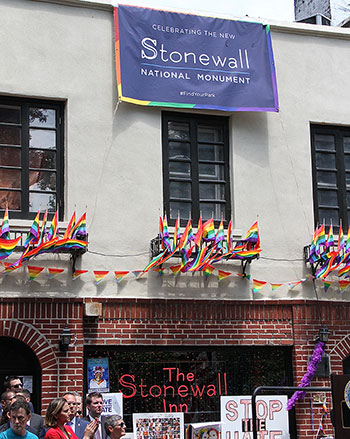All About the Stonewall Riots


Uprising for Gay Rights
The Stonewall Riots, or the Stonewall Uprising, marked the beginning of the Gay Rights movement in New York City’s Greenwich village in 1969. The Stonewall Inn was a gay bar frequented by many LGBT people and often disrupted by frequent police raids. Although there had been many gay rights activists and actions prior to the summer of '69, it is believed that the Stonewall Riots were the catalyst to the modern gay rights movement sparking the movement to real action.
The Stonewall Inn was one of the few gay bars open in 1969. It was allegedly run by the Mafia and was frequented most by the most alienated people within the LGBT community. This means the patrons were usually drag queens, trans people, male prostitutes, homeless youth, feminine men, and butch lesbians--anyone who didn’t fit the expectations of gender identity or the straight male patriarchy.
Police raids were not rare for gay bars like the Stonewall. The constant raids were always legal but relentless. On June 28th, 1969 the patrons of the Stonewall Inn had had enough. While waiting for patrol cars to pick up the patrons who were being arrested, crowds gathered and those waiting for the patrol cars were getting restless. The police quickly lost control of the situation as the people began rioting. This was the beginning of what became known as the Stonewall Riots. They lasted three days and are believed to be the beginning of what will come to be Pride Parades. The New York Times reported that there were 400 people rioting. Eventually the police had been forced to retreat--a first for this kind of protest.
Two notable women involved in the Stonewall Riots were Sylvia Rivera and Marsha P. Johnson. These women are trans women of color and were some of the louder protesters at the riots and went on to talk about their experiences at the riots frequently. Rivera is said to be one of the first to throw glass bottles at the police along with Molotov cocktails. During the riots, Marsha P. Johnson was seen yelling, screaming, throwing rocks and climbing lampposts and dropping heavy bags onto police cars breaking their windshields. After the riots, Johnson and Rivera went on to start the Street Transvestite Action Revolutionaries (STAR) a group dedicated to helping trans women of color.
It’s worth mentioning that the most vocal rioters were women of color but the riots were quickly made to be a symbol of white gay men fighting. It’s said that the defining moment of the riots were when a woman--said to be Stormé DeLarverie, but has never been confirmed--kept breaking away from and fighting police officers from arresting her. It was the first definitive act of refusal and the riots were continued and in some cases, lead by, additional women.
Additional Sources:
http://www.history.com/this-day-in-history/the-stonewall-riot
https://mic.com/articles/121256/meet-marsha-p-johnson-and-sylvia-rivera-transgender-stonewall-veterans#.KzNG0efsK
For Teachers: A TeacherVision lesson plan.







